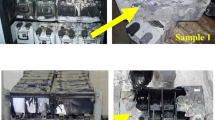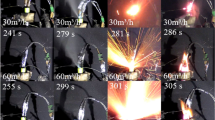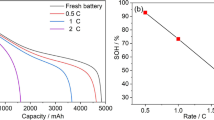The thermal behavior of flooded lead–acid batteries with different distances between their electrodes, in which there takes place a temperature rise, was investigated at different rates of charging and discharging of these batteries with the use of the PIV method. It was established that, in the case of small rates of charging and discharging of such a battery, a decrease in the distance between its electrodes leads to a decrease in the temperature rise and in the heat generation in it, while, in the case where these rates are large, the opposite effects take place.
Similar content being viewed by others
References
B. L. McKinney, G. L. Wierschem, and E. N. Mrotek, Thermal management of lead–acid batteries for electric vehicles, SAE Int. Congress and Exposition. SAE Technical Paper 830229 (1983); https://doi.org/10.4271/830229.
F. Torabi and V. Esfahanian, Study of thermal-runaway in batteries. I. Theoretical study and formulation, J. Electrochem. Soc., 158, No. 8, Article ID 850 (2011).
Z. Rao and S. Wang, A review of power battery thermal energy management, Renew. Sustain. Energy Rev., 15, 4554–4571 (2011).
K. F. Sökmen and M. Çavuş, Review of batteries thermal problems and thermal management systems, J. Innov. Sci. Eng., 1, No. 1, 35–55 (2017).
W. Tiedemann and J. Newman, Mathematical modeling of the lead–acid cell, in S. Gross (Ed.), Battery Design and Optimization, Princeton, NJ (1979), p. 23.
D. Bernardi, E. Pawlikowski, and J. Newman, A general energy balance for battery systems, J. Electrochem. Soc., 132, No. 5 (1985); https://doi.org/10.1149/1.2113792.
W. G. Sunu, Mathematical model for design of battery electrodes: Lead–acid cell modelling, in: Ralph E. White (Ed.), Electrochemical Cell Design, Springer US, Boston (1984), pp. 357–375.
H. Gu, T. V. Nguyen, and R. E. White, A mathematical model of a lead–acid cell, J. Electrochem. Soc., 134, No. 12 (1987); https://doi.org/10.1149/1.2100322.
F. Alavyoon, A. Eklund, F. H. Bark, R. I. Karlsson, and D. Simonsson, Theoretical and experimental studies of free convection and stratification of electrolyte in a lead–acid cell during recharge, Electrochim. Acta, 36, 2153–2164 (1991).
A. Eklund and R. I. Karlsson, Free convection and stratification of electrolyte in the lead–acid cell without/with a separator during cycling, Electrochim. Acta, 37, 681–694 (1992).
J. Landfors, D. Simonsson, and A. Sokirko, Mathematical modelling of a lead/acid cell with immobilized electrolyte, J. Power Sources, 55, 217–230 (1995).
W. B. Gu, C. Y. Wang, and B. Y. Liaw, Numerical modeling of coupled electrochemical and transport processes in lead–acid batteries, J. Electrochem. Soc., 144, Article ID 2053 (1997).
S. C. Kim and W. H. Hong, Analysis of the discharge performance of a flooded lead/acid cell using mathematical modelling, J. Power Sources, 77, 74–82 (1999).
W. B. Gu and C. Y. Wang, Thermal-electrochemical modeling of battery systems, J. Electrochem. Soc., 147, No. 8, 2910–2922 (2000).
V. Esfahanian and F. Torabi, Numerical simulation of lead–acid batteries using Keller-box method, J. Power Sources, 158, No. 2, 949–952 (2006).
K. Siniard, M. Xiao, and S. Y. Choe, One-dimensional dynamic modeling and validation of maintenance-free lead–acid batteries emphasizing temperature effects, J. Power Sources, 195, 7102–7114 (2010).
V. Esfahanian, A. B. Ansari, H. Bahramian, P. Kheirkhah, and G. Ahmadi, Design parameter study on the performance of lead–acid batteries, J. Mech. Sci. Technol., 28, No. 6, 2221–2229 (2014).
V. Esfahanian, A. B. Ansari, and F. Torabi, Simulation of lead–acid battery using model order reduction, J. Power Sources, 279, 294–305 (2015).
H. Pourmirzaagha, V. Esfahanian, F. Sabetghadam, and F. Torabi, Single and multi-objective optimization for the performance enhancement of lead–acid battery cell, Int. J. Energy Res., 40, No. 14, 1966–1978 (2016).
B. Ansari, V. Esfahanian, and F. Torabi, Discharge, rest and charge simulation of lead–acid batteries using an efficient reduced order model based on proper orthogonal decomposition, Appl. Energy, 173, 152–167 (2016).
T. Nazghelichi, F. Torabi, and V. Esfahanian, Prediction of temperature behavior of a lead–acid battery by means of Lewis number, Electrochim. Acta, 275, 192–199 (2018).
M. H. Malekshah, E. H. Malekshah, M. Salari, A. Rahimi, and M. Rahjoo, Thermal analysis of a cell of lead–acid battery subjected by non-uniform heat flux during natural convection, Therm. Sci. Eng. Prog., 5, 317–326 (2018).
M. Salari, A. Kasaeipoor, and E. H. Malekshah, Influence of static bubbles at the surface of electrodes on the natural convection flow for application in high performance lead–acid battery, Therm. Sci. Eng. Prog., 5, 204–212 (2018).
M. Salari, E. H. Malekshah, M. R. Sarlak, M. H. Malekshah, and M. Pilfoush, Hydrothermal investigation of a stratified system in enclosure with jagged surface for application in lead–acid batteries, Multidiscip. Model. Mater. Struct., 15, No. 7 (2018).
S. Nahidi, I. J. Gavzan, S. Saedodin, and M. Salari, Measurement of the electrolyte flow velocity and bubbles characterization during electrochemical reactions in lead–acid batteries using the PIV system, J. Ind. Eng. Chem. (2020); https://doi.org/10.1016/j.jiec.2020.01.035.
T. Nazghelichi, F. Torabi, and V. Esfahanian, Non-dimensional analysis of electrochemical governing equations of lead–acid batteries, J. Energy Storage, 27, 101–120 (2020).
U. Ullum, Imaging Techniques for Planar Velocity and Concentration Measurements, Technical University of Denmark, Denmark (1999).
J. Westerweel, D. Dabiri, and M. Gharib, The effect of a discrete window offset on the accuracy of cross-correlation analysis of digital PIV recordings, Exp. Fluids, 23, No. 1, 20–28 (1997).
J. Chen and J. Katz, Elimination of peak-locking error in PIV analysis using the correlation mapping method, Measur. Sci. Technol., 16, No. 8, Article ID 1605 (2005).
M. Raffel, C. E. Willert, F. Scarano, C. J. Kähler, S. T. Wereley, and J. Kompenhans, Particle Image Velocimetry. A Practical Guide: Springer (2018).
A. A. Mokarrab, Ah. M. Az my, and S. A. Mahmoud, Effect of process parameters on the dynamic behavior of polymer electrolyte membrane fuel cells for electric vehicle applications, Ain Shams Eng. J., 5, No. 1, 75–84 (2014).
D. Linden and T. Reddy, L inden's Handbook of Batteries, McGraw Hill Professional (2011).
M. Kuroda, A. Sakakibara, T. Sasaki, Y. Murai, N. Nagai, and F. Yamamoto, PIV study on buoyant bubble flows in a small electrolytic cell, Jpn. J. Multiphase Flow, 22, No. 2, 161–174 (2008).
M. Wang, Z. Wan, X. Gong, and Z. Guo, The intensification technologies to water electrolysis for hydrogen production — A review, Renew. Sustain. Energy Rev., 29, 573–588 (2014).
A. Taqieddin, R. Nazari, L. Rajic, and A. Alshawabkeh, Review — Physicochemical hydrodynamics of gas bubbles in two-phase tlectrochemical systems, J. Electrochem. Soc., 164, No. 13, E448–E459 (2017).
T. Weier and S. Landgraf, The two-phase flow at gas-evolving electrodes: Bubble-driven and Lorentz-force-driven convection, Eur. Phys. J. Spec. Topics, 220, 313–322 (2013).
R. Hreiza, L. Abdelouahed, D. Fünfschilling, and F. Lapicque, Electrogenerated bubbles induced convection in narrow vertical cells: A review, Chem. Eng. Res. Des., 100, 268–281 (2015).
D. Pavlov, Lead–Acid Batteries Science and Technology, Elsevier: Amsterdam (2011).
H. A. Kiehne, Battery Technology Handbook, Expert Verlag (2003).
J. Jung, L. Zhang, and J. Zhang, Lead–Acid Battery Technologies: Fundamentals, Materials, and Applications, Taylor and Francis Group (2015).
P. C. Bhatia, Thermal Analysis of Lithium-Ion Battery Packs and Thermal Management Solutions, Ohio State University (2013).
D. C. Montgomery, Design and Analysis of Experiments, John Wiley & Sons, New York (2019).
R. H. Myers and D. C. Montgomery. Response Surface Methodology: Process and Product Optimization Using Design of Experiments, John Wiley & Sons, New York (1995).
Author information
Authors and Affiliations
Corresponding author
Additional information
Published in Inzhenerno-Fizicheskii Zhurnal, Vol. 97, No. 1, pp. 64–77, January–February, 2024.
Rights and permissions
Springer Nature or its licensor (e.g. a society or other partner) holds exclusive rights to this article under a publishing agreement with the author(s) or other rightsholder(s); author self-archiving of the accepted manuscript version of this article is solely governed by the terms of such publishing agreement and applicable law.
About this article
Cite this article
Nahidi, S., Salari, M., Gavzan, I.J. et al. Influence of the Generation of Gas Bubbles in Flooded Lead–Acid Batteries on Their Thermal Behavior. J Eng Phys Thermophy 97, 63–77 (2024). https://doi.org/10.1007/s10891-024-02868-4
Received:
Published:
Issue Date:
DOI: https://doi.org/10.1007/s10891-024-02868-4




